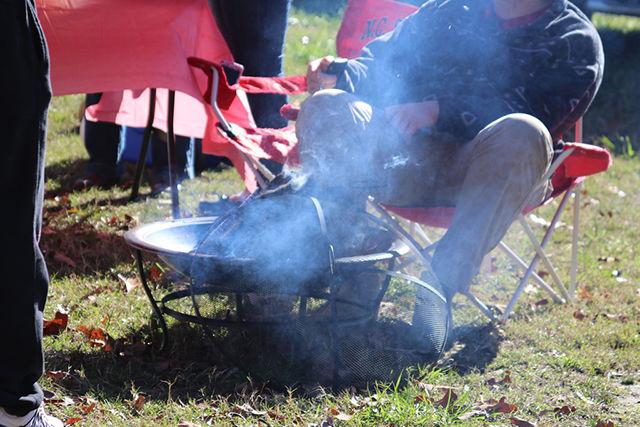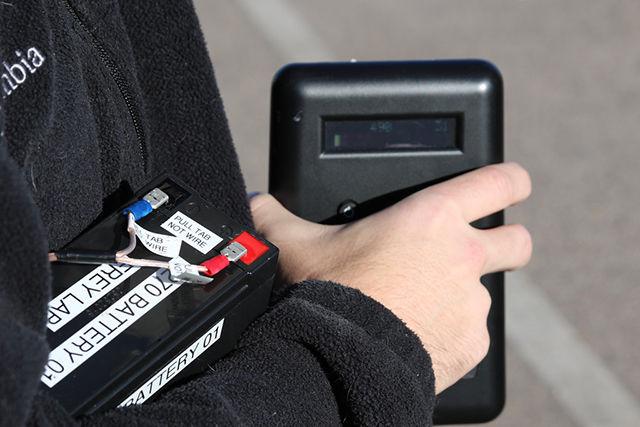At tailgating events, there is a danger to your health less obvious than someone puking on your shoes. Researchers at NC State have discovered that tailgating causes temporary but serious effects to the air quality in and around tailgating lots that could make it harder to party.
College of Engineering professor Chris Frey teamed up with Department of Parks, Recreation and Tourism Management assistant professor Kyle Bunds and associate professor Jonathan Casper to measure the air pollution at tailgate events in the 2015 NC State football season.
“We knew that you can see an increase in hospital visits for respiratory or cardiovascular events whenever there is an elevated air pollution on particular days,” Bunds said. “What we noticed, being long-time sports fans and people who had studied air pollution in the past, is that people at tailgates will idle their cars or use charcoal grills, and they’ll just kind of sit there and take it in for the entire time.”
Casper, Bunds and Frey collected data from six different home football games, but before they even started collecting, they had to figure out if what they were trying to do was even possible.
“The initial idea behind this study was to see if we could quantify it,” Bunds said. “If we could measure air pollution as it related just to the tailgate area and that we could measure and quantify the exact levels people were exposed to.”
Bunds said that the five stationary monitors were placed strategically around the tailgating lots outside of Carter-Finley Stadium in order to capture accurate data about specifically the tailgating lots and not the area around them. Each monitor was placed in a vented lock box and pointed inward toward the tailgate. Factors such as wind and box location had to be carefully considered when placing the box in order to get the most accurate data, according to Bunds.
In addition to the five stationary monitors, the team also brought a mobile monitor that they carried in a backpack. Both kinds of monitors found that the main change in the air around the stadium was an increase in the levels of PM2.5. PM2.5 is an abbreviation for particulate matter that is less than 2.5 micrometers in aerodynamic diameter. For comparison, a human hair is about 80 micrometers in diameter.
“It’s generally not something you can see with your naked eye, but when you have enough of the particles in the air it will reflect or scatter light so you’ll see it has haze or smog or smoke,” Frey said. “The significance of the PM2.5 is that our respiratory systems have natural defenses against particles of various sizes, but not for PM2.5.”
The human body has natural defenses for particulate at various sizes. A particulate at around 10 micrometers in diameter is intercepted by nose hair, nose mucus or throat mucus. A person can usually sneeze or cough these out, according to Frey.
Small particulates around 0.1 micrometers can avoid these defenses but when they reach the bronchioles in the lung, they are swiped away by very small hairs called cilia. The cilia sweep super small particles out of the lungs into the throat to be coughed up.
“These PM2.5particles are small enough that they pass the nose hairs and mucus lining but they are too big to get swept out by the cilia,” Frey said. “They can get into the air sacs in the lungs and potentially cross the membrane into the bloodstream.
Health effects from exposure to PM2.5affect the respiratory and the circulatory system. According to Frey, there’s a lot of epidemiological evidence to support the correlation between PM2.5 and these kinds of health effects after prolonged exposure to these particles.
Bunds said that the PM2.5spikes occurred mostly around idling cars, charcoal grills and older power generators.
“As we’d walk around, we’d see the different spikes so this year we’re putting stationary monitors at individual tailgates and have people record their [tailgate’s] activities,” Bunds said. “This would tell us what they’re doing at specific times and what they’re using for their fuel to grill food and if they have a generator.”
Bunds said that the team is switching focus this year into analyzing tailgaters’ behavior.
“We [now] know that we can quantify and see what goes on, isolated to the tailgate area, but we want to see this year if you [tailgaters] know that charcoal is more hazardous to your health, are you still going to use charcoal?” Bunds said. “What changes are you willing to make and what policy implementations are you willing to accept to improve the air quality?”
Bunds said using electric or propane grills, not idling cars and replacing older generators with newer ones are all ways tailgaters can work towards improving the air quality in the lots.
Another, less well-known solution would be to use solar energy. Bunds said that during their research last year, they came across a campsite that used two small solar panels used to power a stereo system and TV.
“We’ve met informally with people in the athletics department and the office of sustainability, and we’re trying to create a committee through the athletics department,” Bunds said.
According to Bunds, the group hopes its research this season will help them find different ways to reach out to fans, understand its desires and try to figure out how to improve the situation.









